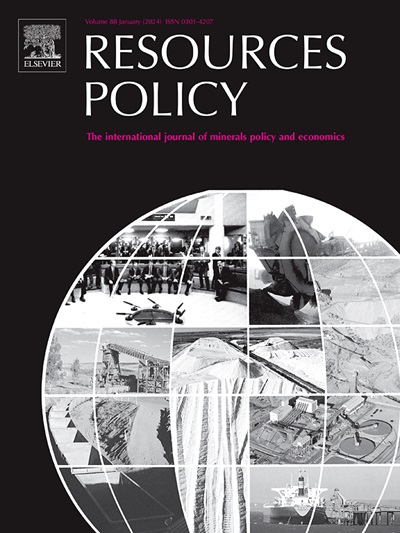The effects of global uncertainty and risks on metal prices: Evidence from frequency and time domain causality tests
IF 10.2
2区 经济学
0 ENVIRONMENTAL STUDIES
引用次数: 0
Abstract
Metal prices are heavily affected by global uncertainties and risks. Empirical studies have analyzed the causality between global uncertainties, risks, and metal prices using traditional methods and ignored the frequency and time-domain relations. The study aims to fill the existing research gap by analyzing the relationship between global uncertainties and risks and metal prices, considering the effects on the supply side of metals and their prices on the demand side. Therefore, using the news-based GEPU and GPR indices for 1990:01–2024:04, the relationships between uncertainties and risks and price returns of the most traded base and precious metals in international markets are analyzed with frequency and time domain Granger causality tests. The results show that the relationship between GPR and GEPU and the returns of metals is not uniform enough to be explained by the traditional Granger causality tests used in previous studies and varies significantly according to the frequency-time domain. According to the frequency domain, unidirectional and bidirectional causality relationships were found between GPR and GEPU and metal prices in the short, medium, and long run. In addition, in the time domain, the causality relationships between GPR, GEPU, and metal price returns coincide with periods of increased uncertainties and risks or economic recessions such as the 2008 global financial crisis and the COVID-19 pandemic experienced by the global economy. These results emphasize the importance of strategic planning for the sustainability of economic development, as governments should diversify markets and turn to alternative sources of supply for the supply of needed metals.
全球不确定性和风险对金属价格的影响:来自频域和时域因果检验的证据
金属价格受到全球不确定性和风险的严重影响。实证研究采用传统方法分析全球不确定性、风险和金属价格之间的因果关系,忽略了频域和时域关系。本研究旨在通过分析全球不确定性和风险与金属价格之间的关系,考虑金属供给侧的影响及其对需求侧价格的影响,填补现有的研究空白。因此,利用1990:01-2024:04年基于新闻的GEPU和GPR指数,运用频域和时域格兰杰因果检验对国际市场上交易量最大的基本金属和贵金属的不确定性、风险与价格收益之间的关系进行分析。结果表明,探地雷达和GEPU与金属收益之间的关系并不均匀,不能用传统的格兰杰因果检验来解释,并且在频域上存在显著差异。从频域上看,GPR和GEPU与金属价格在短期、中期和长期均存在单向和双向的因果关系。此外,在时域上,GPR、GEPU和金属价格回报之间的因果关系与不确定性和风险增加或经济衰退的时期相吻合,例如2008年全球金融危机和全球经济经历的COVID-19大流行。这些结果强调了战略规划对经济发展可持续性的重要性,因为政府应该使市场多样化,并转向其他供应来源来供应所需的金属。
本文章由计算机程序翻译,如有差异,请以英文原文为准。
求助全文
约1分钟内获得全文
求助全文
来源期刊

Resources Policy
ENVIRONMENTAL STUDIES-
CiteScore
13.40
自引率
23.50%
发文量
602
审稿时长
69 days
期刊介绍:
Resources Policy is an international journal focused on the economics and policy aspects of mineral and fossil fuel extraction, production, and utilization. It targets individuals in academia, government, and industry. The journal seeks original research submissions analyzing public policy, economics, social science, geography, and finance in the fields of mining, non-fuel minerals, energy minerals, fossil fuels, and metals. Mineral economics topics covered include mineral market analysis, price analysis, project evaluation, mining and sustainable development, mineral resource rents, resource curse, mineral wealth and corruption, mineral taxation and regulation, strategic minerals and their supply, and the impact of mineral development on local communities and indigenous populations. The journal specifically excludes papers with agriculture, forestry, or fisheries as their primary focus.
 求助内容:
求助内容: 应助结果提醒方式:
应助结果提醒方式:


